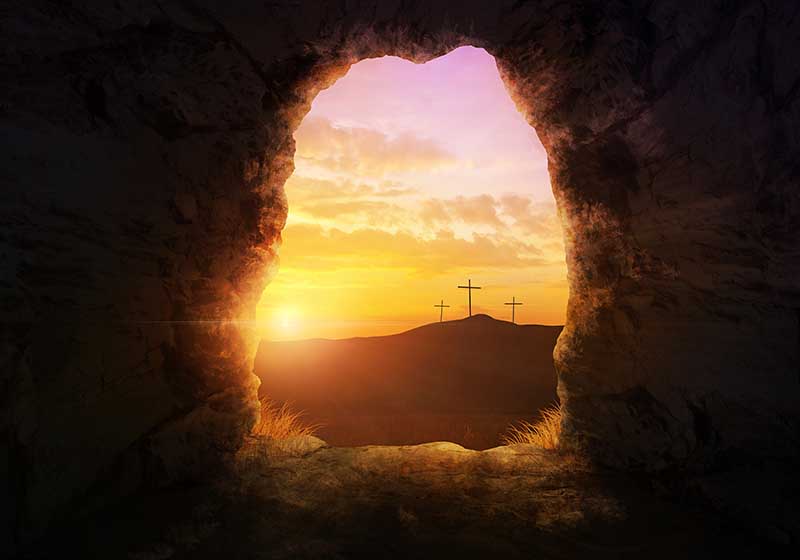
Easter Hero: Changed and Grateful
March 24, 2016
“Ananias” (from the “Peter & The Holy Spirit” Series)
April 14, 2016
What is the most significant difference between Christianity and the other world religions? Yes, we could say that 1. It is not a religion at all, but a way of life centered on a personal relationship, and yes, we could say that 2. It is the only “religion” that shuns earning one’s salvation and instead presents the gift of grace as the path to righteousness, and yes, we could say that 3. Jesus states very clearly that He is the way – the only way – to salvation, and yes, we could say that 4. Jesus is the only leader who claimed to be God – and, yes, all that is explicitly true. I am even willing to stake my career on it- which, by the way, I did.
But the above are what I would call “insider insights.” I mean by that these are beliefs that may seem clear to Believers, but remain murky to those on the outside of Christianity looking in – at best murky, and more likely narrow minded, or simple-minded, bigoted, or just plain weird. (I might also add that to many who are in church on most Sundays, these may be so familiar that they may have become … unfamiliar in their significance. )
Why do so many hold that “all religions lead to the top?” Why do so many feel that all the religions teach pretty much the same thing, and that if we would just live out our beliefs, no matter the particular religion, the world would be fine? The simple answer is because from the outside looking in they all do appear to teach the same principles.
Now from my perspective, as an apprentice to Jesus, His teachings are very different from Mohammed, Confucius and Buddha. Jesus is a maestro, producing Life to the Full. (John 10:10) The others have, well, some positive and soulful things to say, and some … not so much. But, from the world’s perspective? Pretty much the same.
So, again, the question: What is the most significant difference? Is there an undeniably separating fact to which we can point and say, “Okay, that is cosmically unique; that is indeed a tangible difference that cannot be “just part of the pack?”
Clearly that most significant difference is the fact that there is an empty tomb in Jerusalem.
Can that little detail be explained away? If one happens to think Jesus was a great man, a prophet even, someone we should certainly emulate, but maybe not this Son of God stuff, please help me overcome the fact that I cannot find anyone with a plausible explanation for no Jesus body … anywhere.
By the way, there have been several brilliant, but spiritually skeptical men – respected scholars and lawyers – who realized the overwhelming significance of this little detail. They set out to disprove the resurrection, utilizing legal and/or scholarly approaches; and lo and behold, became born again Christians in the process. C.S. Lewis being perhaps the most well known.
The Legal Perspective
Let’s pause for a moment to hear from Circuit Court Judge Mark Hayes on the rules of evidence and the jury’s responsibilities. If this is too much detail please read at least the parts in bold:
The decision a jury makes in a court of law must decide the truth of the issue presented before them. The jury’s purpose is to determine the facts. It is up to the jury to examine the evidence and to determine the inferences which they feel may properly be drawn from the evidence presented by the witnesses.
In determining whether to believe a witness or a piece of evidence, the jury has the right to consider the interest of the witness in the matter presented, the bias of any witness, the prejudice of any witness, the opportunity for the witness to have seen the matters and things about which the witness may testify, and the way the witness may have acted on the witness stand.
There are two types of evidence generally presented during a trial, direct and circumstantial evidence. Direct evidence is testimony of a person who claims to have actual knowledge of a fact, such as an eyewitness. It is evidence which immediately establishes the main fact to be proved.
Circumstantial evidence is proof of a chain of facts indicating the existence of a fact. Circumstantial evidence is based on inference and not on personal knowledge or observation.
The law makes no distinction between the weight or value to be given either direct or circumstantial evidence. Thus the members of the jury can feel assured that either evidence can be relied upon in making his or her decision.
A jury only makes its decision or its verdict once the burden of proof has been met. In either a criminal case or a civil case the burden is met once the probability of the fact being proved is established. Truth is determined from the probability of the fact not the mere possibility of a fact. In any court case, the jury will hear many possibilities but their verdict or the truth rests on the probability that a fact did occur.
———————————————————————————————————–
Explanations
Okay, what could have happened?
1) The body was dumped unceremoniously into a grave used for common criminals and the story of Joseph of Arimethea was “developed” to cover this fact.
The simple answer to this possibility, which we will return to again because it has such an enormous weight in this discussion, is if this were the case, the Jews would have been quick to announce this, in light of the disciples’ declarations of the risen Jesus.
One can only imagine how swiftly and thoroughly the Jews’ response would have been to the news from the disciples. “No!” they would have shouted from the temple to the tomb, “We dumped the body in the pit over the west wall. There is no empty tomb. Joseph of Arimathea, and you, Nicodemus, if you don’t validate this fact you will be worshipping with the filthy shepherds and eating pork sandwiches come next Saturday!”
Yet, and please do not miss the overwhelming weight of this, there is not one sentence, not one shred of writing from the first century Jews, denying the empty tomb. Not anything? Oh, come on, that just cannot be so. The Jews were both prolific writers and record keepers, and also meticulous to the point of being a tad anal about the copying and then safeguarding of their important documents.
And, for the Jewish leaders of that time, there could not have been a more important document. Yet, n-o-t-h-i-n-g. Not one thing denying the empty tomb. How could they? There was in fact an empty tomb and no explanation for it.
2) Jesus did not actually die, he just “passed out.” This is commonly referred to the Swoon Theory.
Did anyone see the movie The Passion? This was verified by many independent sources as an accurate depiction of what happened to Jesus.
The facts: He was flogged 39 times. This often killed the victim.
He was nailed to a cross.
A spear was thrust into His heart and John’s description – tells us that blood and water flowed out from the wound. This has been validated as a medically accurate description of the result of a spear to the heart area.
He was pronounced dead by the trained and experienced Roman Centurion in charge of the execution. (Mark 15:44-45)
He was laid in a damp cave for three days, wrapped in heavy burial linens.
And yet He somehow woke up, moved the stone aside, slipped by the guards, walked to His disciples, and appeared to them with the strength and vitality of a risen Messiah? What a guy!
3) The disciples – and I guess the Jews, the Romans and everybody else – went to the wrong tomb.
No comment necessary
4) The disciples never truly saw a bodily, risen Jesus. They hallucinated.
Psychiatrists all agree that hallucinations do not occur in groups, and
certainly not in masses (Read about the 500 witnesses at 1 Corinthians 15: 3-8 )
They also agree people hallucinate when they are desperate for something to be true, or expecting – even anticipating – it to be so. This simply does not fit the disciples’ post-crucifixion state of mind. They were totally defeated and dejected, having given up all hope. Jesus was dead.
5) The body was stolen.
At last a plausible explanation. But who stole the body, and why? Remember, motive plays a key role in evaluating credibility.
The Romans stole the body: But why would they? Jesus was nothing but an insignificant little country Jew.
The Jews stole the body to keep the disciples from doing so.
The simple answer to this possibility is the same as for #1 above: they would have emphatically said so to dispute the empty tomb.
The butler did it. Okay, just a little humor.
The disciples stole the body. Of course! The obvious culprits.
Motive? By stealing the body they could claim that Jesus was the Messiah, thus validating themselves, their leader and their mission.
But, we see very clearly that they were clueless as to Jesus’ pre-crucifixion words that He would rise. (Luke 24:25 , John 20:9)
They weren’t exactly the model for courageous and inspired followers.
They were in fact cowering in a locked room. (Mark 14:50-52)
So are we to believe that this little band of scared, humiliated and discouraged fisherman and such suddenly mounted up and assaulted a tomb that was guarded by trained soldiers? Would any of you care to take on 6-12 (The typical contingency of a guard) US Army Rangers, armed to the teeth? With one or two swords? (Luke 22:38)
Or, maybe the guards fell asleep. (Matthew 28:11-15)
Of course the penalty for such would be death. I don’t know about you, but that would tend to keep me awake. And 6-12 guards all snoozing away at the same time, even while the disciples rolled a 1000+ lb stone out of the way? Even more, the disciples, in the midst of this stealth caper, took the time to neatly fold Jesus’ burial linens? What neat freaks they must have been. (John 20:7)
But let’s say they actually did. Are we to believe that this assault would not have made its way into someone’s publication and that the Jews and the Romans just happened to stay silent on this fact, even as the disciples marched around Jerusalem proclaiming a risen Jesus? Really?
And, are we to believe that there were no subsequent arrests by the Roman authorities for violating a Roman seal?
Furthermore, let’s consider the disciples after this alleged assault:
First, the change in their demeanor: From scared and scattered to bold and brave. After they stole the body they were suddenly transformed into apostles so brave and bold as to face being ostracized at best, to flogging – did anyone see the flogging in The Passion? – torture, stoned to death, being sawn in half, crucified upside down, dropped in a vat of oil and, you name it, they got it.
Second, not once did any of them stop theses horrors and admit they had fabricated the whole story. I recall confessing my misdeeds after one whack of the paddle at school – much less a leather whip with stone and bone embedded in the ends, ripping and tearing my flesh off my shoulders thirty-nine times. At least one of the men, facing that type of devastatingly horrible pain, would have had to say, “Okay, okay, we made it up already!” See Attachment #1 – “Watergate Proves the Resurrection.”
Remember, they did not get a book deal out of this. There were no talk shows or speaking tours with fat paychecks. No, they got tortured. They got killed.
Come on members of the jury! We can not be asked to believe this.
You see, as Andy Stanley of Northpoint Church puts it so succinctly, the disciples were not willing to die for what they believed or even what they believed in – plenty of people have and continue to do that. (But rarely, if ever, will anyone die for a lie.)
No, the disciples were willing to die for what they … saw.
When we read the disciples’ first “sermons” we see very little theology about Jesus’ teachings. They simply insist they have seen Jesus alive after he was dead and buried. Look closely at their messages in Attachment #2 – “Eyewitnesses.”
“God has raised this Jesus to life, and we are all witnesses to this fact.” Acts 2:32
Ancillary Facts
1) The overwhelming majority of historians – both conservative and skeptical – agree that:
2) Jesus lived in Palestine in the first century A.D,
3) Jesus was crucified
4) The disciples had a life-altering experience that radically transformed them from cowards to bold, brave and inspired apostles
5) Saul was a persecutor of the new Christians and he, too, had a life-altering experience that changed him into a radical and inspired apostle for Jesus.
6) James was Jesus’ little brother and he was a skeptic during Jesus’ life, but he too had a life-altering experience that changed him into a bold, brave and inspired apostle and leader of the first century Christian church in Jerusalem.
Furthermore, these historians all agree that what these men said changed them so radically was that they saw Jesus alive after they had seen Him crucified and dead.
The skeptics just don’t agree that they actually saw Jesus.
Now that seems to be staking out a shaky position on a 5% possibility, as opposed to a 95% probability.
- Circumstantial evidence for a risen Jesus (Remember the rules of evidence give this equal value)
- The radical change in the disciples, Paul and James
- Silence of the Jewish leaders
- Success of the early church despite intense persecution
- Shift from a Saturday Sabbath to a Sunday Sabbath
- Jesus’ own predictions and the credibility of his character
Summary
We have direct eyewitness reports from people whose character appears beyond reproach, with no motive to lie and overwhelming motive not to.
We have circumstantial evidence that all points to the same conclusion.
We have the complete absence of hostile witnesses. To me their silence is a quiet roar.
Remember the role of the jury in determining the true facts of a case as described by Judge Hayes. Ponder and examine the evidence related to the empty tomb and play the role of a member of the jury deciding the case of the empty tomb. Is the evidence credible? Can you rely on the evidence? Can the witnesses be believed? Does the evidence present a mere possibility of an empty tomb or does the evidence convince you of its overwhelming probability?
Your verdict?
Okay, So What?
The fact that there is an empty tomb means Jesus is who He said He is – God, manifest bodily into our world as the Son of God. As C.S. Lewis says,
I am trying here to prevent anyone saying the really foolish thing people often say about Him: “I’m ready to accept Jesus as a great moral teacher, but I don’t accept His claim to be God.” That is the one thing we must not say. A man who was merely a man and said the sort of things Jesus said would not be a great moral teacher. He would either be a lunatic – on a level with the man who says he is a poached egg – or else he would be the Devil of Hell. You must make your choice. Either this man was, and is, the Son of God: or else a madman or something worse. You can shut Him up for a fool, you can spit at Him and kill Him as a demon; or you can fall at His feet and call him Lord and God. But let us not come with any patronizing nonsense about His being a great human teacher. He has not left that open to us. He did not intend to. (Mere Christianity)
Maybe you have a few doubts about the whole Adam and Eve thing … perhaps the Noah story or the Jonah and the big fish thing is a bit of a stretch for you. Or maybe the Sodom and Gomorrah story seems more legend than historical fact. This of course means that subtly, and maybe even unconsciously, you take the Bible as, well, “Okay, it’s good stuff, but for crying out loud one cannot take it literally.”
Well you see, Jesus, the man who predicted his own death and resurrection – and pulled it off – believed and taught about all these things: Adam & Eve, Noah, Jonah, even Sodom and Gomorra. He also stated very clearly that the Bible is God’s Word, never to be abolished (Matthew 5:17) nor broken (John 10:35). So I think I’ll believe what Jesus believed. If God can pull off the miracle of raising Jesus from the dead, then all these other miracles become so much easier to accept.
Or, maybe life has turned upside down and you can just not make any sense out of it. The fog has rolled in and God just seems no where to be found. How could a loving God let this happen to me?
Now there is meaning to this life beyond this life. When we zoom back to the 30,000 foot level – or the, “ What will ultimately matter 75 years from now” viewpoint – our current problems and even our disasters, take on a different, slightly less overwhelming perspective.
And that is the key. The empty tomb affords us an Eternal Perspective.
Developing an Eternal Perspective will radically transform our view of this world, and it’s problems. Viewing our circumstances through an Eternal Perspective will progressively mitigate our sorrows and enhance our joy.
Finally, since Jesus appears to be who He said He is, doesn’t that warrant a closer scrutiny of His life and His words? He said, “I am God.” Wouldn’t, shouldn’t a proclamation like that require a complete revamping of our lives? It would seem ridiculous to just “ho-hum” our way through the typical Sunday morning Christian thing – just phoning it in – paying only nominal attention to the teachings and commands of this Son of God.
This Easter I challenge you to let the true significance of this empty tomb in Jerusalem flow over and through you. You’re a bright person; you decide how that should affect the details of your life. But affect them it should.
Attachments:
#1 -Watergate Proves the Resurrection
Chuck Colson, former legal counsel for President Nixon, states that Watergate proves the resurrection. He relates that at the beginning of the investigation into the Watergate break-in, neither he, nor the other advisors to Nixon, felt any concern over the matter, assuming it was unrelated to the President.
Even as it became more and more clear that the White House could be implicated, the “inner circle” of advisors resolved to protect the Presidency at all costs. Then the day came when John Dean uttered those infamous words to Nixon, “Mr. President, there is a cancer on the Presidency.”
At that point Colson recalls that for the first time they realized the seriousness of the problem, and the legal dangers for each of them. Within a couple of weeks he tells us that each advisor had broken ranks and hired legal counsel to protect their own hides.
Colson compares this “inner circle” of the most powerful men in America, and possibly the world, to the disciples: a band of ostracized, socially disconnected and insignificant blue collar laborers.
These powerful men, who at the time could bully both the Congress and the press around, could call for a military jet anytime they desired to fly wherever they ordered, yet they couldn’t maintain their silence and hold their loyalty for two weeks. And yet the disciples were able to maintain their “fabricated lie” for forty years? And not just in the face of mere legal problems, but horrible torture and murder?
That alone, says Colson, proves that the resurrection must be true. There is no other explanation for the disciples’ bravery and commitment, other than they saw, and personally experienced Jesus alive, and simply could not, much less would not, deny what they … saw.
Not what they believed, but a fact to which they were eyewitnesses.
#2 – Eyewitnesses
What they said they saw:
Acts 1:21-22 Therefore it is necessary to choose one of the men who has been with us the whole time … For one of these must become a witness with us of his resurrection.
2: 22-29-36 God has raised this Jesus to life and we are all witnesses of the fact.
3:11-16 You killed the author of life, but God raised him from the dead. We are witnesses of this.
4:8-20 It is by the name of Jesus …, whom you crucified but whom God raised …
- We cannot help speaking about what we have seen and heard.
5:27-32 We must obey God rather than men. …God raised Jesus from the dead – whom you killed … We are witnesses of these things …
10:39-41 We are witnesses of everything he did … They killed him … God raised him from the dead on the third day and caused him to be seen. He was not seen by all the people, but … by us who ate and drank with him after he rose from the dead.
26:12-26 What I am saying is true and reasonable. The king(Agrippa) is familiar with these things … none of this has escaped his notice, because it was not done in a corner.
Post-resurrection appearances:
To the women: Matthew 28:1-10 Mark 16:1-8 Luke 24:11 Nonsense John 20:10-18
The disciples: Matthew 28:16-20 Mark 16:14 Luke 24:36-49 John 20:19-31
( Over a 40 day period – Acts 1:3 )
The two disciples on the road to Emmaus: Mark 16:12-13 Luke 24:13-35
To Peter: Luke 24:33-34
To six disciples while fishing: John 21
To Paul: Acts 9:1-9 and 26:12-18
To 500 others: 1 Corinthians 15:3 – 8
The Resurrection Day Appearances of Jesus (during Sunday)
- Jesus appears to Mary (not the gardener!) [Jn 20:11-18]
- Jesus appears to the other women [Mt 28:9-10]
- Temple guard inform RL of angel and empty tomb, then are paid off to keep quiet about it [Mt 28:11-15]
- Jesus appears to Cleopas and companion on road to Emmaus [Lk 24:13-22] (late afternoon)
- Jesus appears to Peter [Lk 24:34; 1 Cor 15:5a]
- Cleopas and companion meet with most of the other disciples and Jesus appears to them behind locked doors [Lk 24:36-43; Jn 20:19-23] (evening)
- Thomas does not believe they have seen Jesus [Jn 20:24-25]
Post-Resurrection Appearances of Jesus (during 40 day period after Resurrection)
- One week after resurrection day to Thomas and 10 other disciples; again behind locked doors [Jn 20:26-31; 1 Cor 15:5b]
- To 7 of His disciples in Galilee an unknown number of days afterwards (“Peter, do you love Me?”) [Jn 21:1-25]
- To the 11 on a mountain in Galilee (Great Commission) [Mt 28:16-20]
- To 500 disciples at one time [1 Cor 15:6]
- To His “brother” James [1 Cor 15:7]
- Various other meetings with the 11 during the 40 day period after the Resurrection [Lk 24:44-49; Acts 1:3-8]
The Ascension of Jesus (40th day after Resurrection)
- Jesus leads the 11 out to Mt of Olives (near Bethany) [Lk 24:50]
- Jesus blesses the 11 [Lk 24:51]
- Jesus is lifted up into sky until “received” into cloud and disappears Lk 24:51; Acts 1:9]




